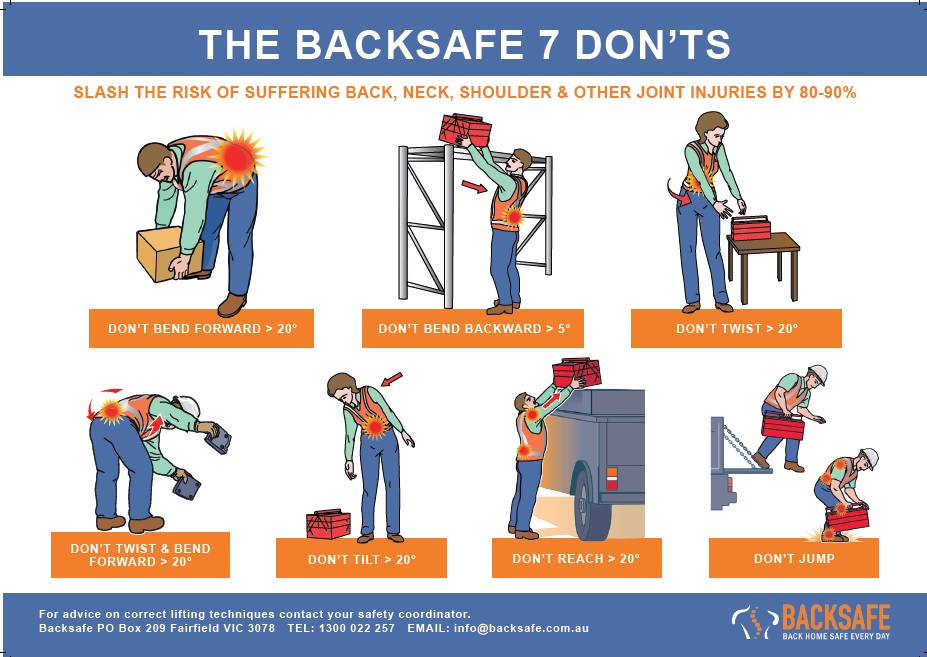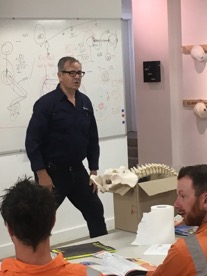Manual handling is an essential aspect of workplace safety that involves the lifting, moving, and transporting of objects. However, it is also a common cause of injuries if not done correctly. In this article, we will explore the importance of manual handling, common injuries that may occur, as well as provide seven helpful tips for manual handling at work.
Understanding the Importance of Manual Handling
Manual handling plays a crucial role in maintaining a safe working environment. It refers to the tasks where individuals are required to lift, lower, push, pull, or carry objects. By understanding the importance, employers can implement appropriate measures to reduce the risk of injuries in their workplaces.
Manual handling is not just about lifting and carrying objects; it also involves assessing the weight, size, shape, and awkwardness of the items being handled. Proper training on correct lifting techniques and the use of mechanical aids can significantly reduce the risk of injuries. Additionally, creating a work environment that promotes proper posture and body mechanics can further enhance the safety of manual handling tasks.
The Role of Manual Handling in Workplace Safety
Manual handling is an integral part of workplace safety as it ensures the well-being of employees. A comprehensive approach to manual handling reduces the risk of accidents, protects employees from injuries, and promotes a culture of safety within the organisation.
Employers have a legal obligation to provide a safe working environment for their employees, including implementing measures to prevent injuries related to manual handling. This can include conducting risk assessments, providing appropriate equipment, and offering training programs to educate employees on safe manual handling practices.
Common Injuries from Incorrect Manual Handling
Incorrect manual handling techniques can lead to various injuries. These injuries can range from minor strains and sprains to more severe conditions such as herniated discs, fractures, and musculoskeletal disorders. It is important to understand the risks associated with manual handling to prevent such injuries from occurring.
Repetitive manual handling tasks without proper rest periods can also contribute to the development of chronic conditions such as tendinitis and carpal tunnel syndrome. By promoting awareness of the potential injuries that can result from incorrect manual handling, employers can empower their employees to prioritize safety and take proactive measures to prevent long-term health issues.
The Basics of Manual Handling
Before diving into the 7 helpful tips for manual handling, it is essential to understand the basic principles of safe manual handling. Adhering to these principles can significantly minimise the risk of injuries and ensure the well-being of employees.
Manual handling is a crucial aspect of many industries, from healthcare to manufacturing. It involves the transporting or supporting of loads by hand or bodily force. Understanding the weight, size, shape, and nature of the load is essential before attempting to handle it. Proper manual handling not only prevents injuries but also increases efficiency in the workplace.
Key Principles of Safe Manual Handling
Safe manual handling involves assessing the load, using proper lifting techniques, utilising manual handling equipment when necessary, taking regular breaks to prevent fatigue, maintaining physical fitness, receiving proper training, and creating a safety culture at work. These principles lay the foundation for effective manual handling.
Regular training sessions on manual handling techniques can help employees stay updated on best practices and prevent complacency. It is important for organisations to provide ongoing support and resources to ensure that employees are equipped to handle various manual handling tasks safely and efficiently.
Seven Helpful Tips on Manual Handling at Work
Now that we have a solid understanding of the basics, let’s explore seven helpful tips for manual handling at work:
Tip 1: Avoid Bending Forward
Bending your back forward more than 20 degrees can put significant strain on the spinal column and if done excessively, can lead to musculoskeletal injuries.
The spinal column works best when in a straight up and down position, following the natural curves of the body.
When lifting or working in a lower position, whether having to pick something up or place something down, it is important to maintain a straight back ensuring to bend at the knees and allowing your legs to lift majority of the load.
It’s important not to use your spine as a lever (that is, not bending over from the hips).
Lifting in a straightened position and using your legs for power allows the load to be transferred evenly and more predictably, making it a much safer manual handling technique.
Tip 2: Avoid Bending Backwards
Arching or bending backwards more than 5 degrees can exert pressure on the base of your spine, which over time can lead to MSD. This backward bending misaligns the spine’s natural curvature, creating a risky posture for your back & entire body.
When grabbing or placing objects overhead, such as on a high shelf, it’s vital to maintain an upright position for your spine, preserving the natural curves and ensuring now backwards bend occurs.
Tip 3: Avoid Twisting
Rotating your torso more than 20 degrees to either side without moving your feet places stress on the lower back’s discs. The lower back is not designed to handle significant lateral movements such as twisting.
Therefore, twisting should be avoided whether standing or seated. Twisting stresses the intervertebral discs by loosening the fibrous bands on one side while tightening them on the other, increasing the risk of a disc rupture.
To change direction safely, pivot your feet and rotate your entire body to mitigate injury.
Tip 4: Avoid Twisting & Bending Forwards
Combining a torso twist with a forward bend, each beyond 20 degrees – can be especially hazardous. This action focuses stress and tension directly onto the lower back’s vertebra, ligaments, tendons, and discs.
This dual movement not only strains but multiplies the tension in the lower back, presenting immediate danger. Such practices can quickly lead to severe intervertebral disc and soft tissue damage, escalating MSD risk.
Tip 5: Avoid Tilting
Sideways tilting of the torso beyond 20 degrees mimics the damaging effects of twisting. The action can unevenly load one side of the lower back, stretching and straining the opposite side.
Such tilts, especially in an already compromised back, can trigger immediate herniation or bulging of discs, along with other soft tissue injuries.
Tip 6: Avoid Reaching
Reaching or stretching too far from your body to lift a heavy object places significant strain on your shoulders and upper back, including the area between the shoulder blades. This strain can extend into the lower back.
Holding an object 60cm from your body can triple the pressure exerted by the load.
For instance, a 10kg weight held 60cm away from your body can create around 30kg of pressure, putting large amounts of pressure on the shoulder joints. This can lead to shoulder joint damage and problems in the mid to lower back as the body compensates for the overload.
Tip 7: Avoid Jumping
Jumping, whether off a truck, a loading dock, or the last few stairs of a staircase, generates a shockwave of pressure that can be 7 to 10 times your body weight. This impact can be detrimental to your spinal health.
The shock starts in the feet and travels up through the ankles, knees, hips, and into the lower spine upon landing. Similar to the impact experienced by athletes in sports like cricket or basketball. Jumping can wear down the cartilage throughout your body that serves as shock absorbers and also significantly damage the spinal discs.

It is important to note that manual handling injuries can have long-lasting effects on an individual’s health and well-being. These injuries can range from sprains and strains to more severe conditions such as herniated discs or torn ligaments. By following these tips, you can significantly reduce the risk of such injuries and create a safer work environment for yourself and your colleagues.
Additionally, it is worth mentioning that certain industries, such as healthcare or construction, may have specific guidelines and regulations regarding manual handling. It is crucial to familiarise yourself with these industry-specific requirements and ensure compliance to further enhance safety.
Implementing Manual Handling Best Practices
By following these seven helpful tips, employers and employees can work together to create a safer working environment. However, it is important to remember that manual handling practices should be continuously assessed, reviewed, and improved to ensure the highest level of safety for all employees.
Creating a Safe Workplace Environment
Employers should create a workplace environment that prioritises safety. This includes providing appropriate manual handling equipment, conducting regular risk assessments, and implementing effective control measures to eliminate or minimise unsafe manual handling practices.
It is crucial for employers to also consider ergonomic factors when designing workspaces and tasks. Ergonomics focuses on optimising the interaction between people, equipment, and the work environment to enhance safety and efficiency. By incorporating ergonomic principles into the workplace, employers can reduce the risk of musculoskeletal disorders and improve overall employee well-being.
Encouraging Employee Participation in Safety Practices
Engaging employees in safety practices is essential for creating a positive safety culture. Encourage employees to voice their concerns, provide feedback, and actively participate in safety initiatives, including training sessions and safety committees.
Furthermore, fostering open communication channels between management and employees can lead to a more collaborative approach to safety. Regular safety meetings, toolbox talks, and feedback mechanisms can help cultivate a culture where safety is everyone’s responsibility.
By following these guidelines, employers can ensure the well-being of their workforce and reduce the risk of injuries associated with manual handling. Remember, safety should always be the top priority, and everyone has a role to play in maintaining a safe workplace environment.



